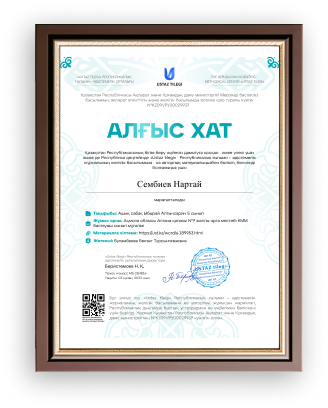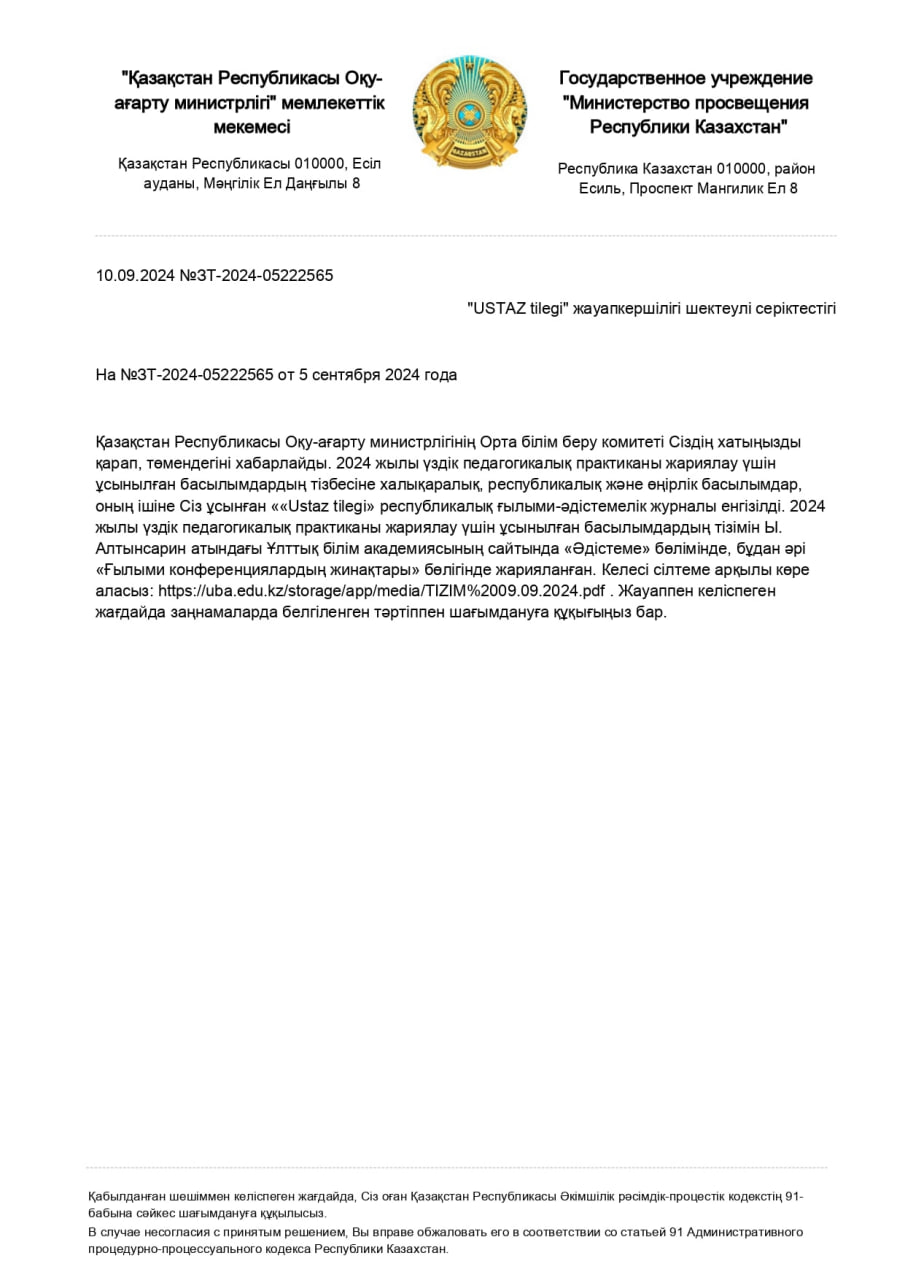SUMMATIVE ASSESSMENT TASKS FOR TERM
3
Summative assessment for the units «Reading for Pleasure» and
«Traditions and Language»
|
Learning objectives
|
9.4.5.1 Deduce meaning from context in extended
texts on a range of familiar general and curricular
topics
9.3.4.1 Respond with growing flexibility at both
sentence and discourse level to unexpected comments on a range of
general and curricular topics
9.3.7.1 Use appropriate subject-specific
vocabulary and syntax to talk about an increased range of general and
curricular topics;
9.3.8.1 Recount extended stories and events on a range of general and curricular topics
|
|
Assessment criteria
|
-
Identify the meaning from context
-
Deliver effective reply speeches or comment on the partner’s speech without
preparation
-
Use
topic related vocabulary and syntax to express the opinion
-
Retell extended stories and events
|
|
Level of thinking skills
|
Knowledge and comprehension Application
Higher order thinking skills
|
|
Duration
|
20
minutes
|
|
Reading
Task 1. Read the text and circle True (T) or False (F) for the statements 1-6.
Hallowe’en
Hallowe'en is a popular festival in many countries all over the world, and every year it seems to get bigger. Find out some more about the
traditional festival of Hallowe'en.
The origins of the name
The festival of Hallowe'en has its (0)
roots
in Celtic and Roman
traditions. Over 2,000 years ago the Celts in Britain, Ireland and
parts of France celebrated Samhain to (1) mark the beginning of winter. When the Romans invaded,
they merged this with Feralia, their celebration of the passing of
the dead. As Christianity spread, the Church tried to replace these
pagan feasts with official Church holy days. One of these was
November 1. It was called All Saints Day, or "All Hallows", and
October 31 was known as "All Hallows' Eve", and then
Hallowe'en.
Hallowe'en traditions
In the past there was a tradition called
"souling". Poor people went around houses asking for food. In
exchange, they promised to say prayers for the dead. People no longer go
souling, but the habit has been transformed into a modern
Hallowe'en game for children in America, who dress up as ghosts,
witches and monsters and go around people's houses, asking for
sweets. This game is called ‘Trick or Treat’.
Witches
Hallowe'en wouldn't be fun without witches.
Witches have always been part of popular folklore. Shakespeare's
(2) play "Macbeth" opens with three witches. A witch was
someone - usually a woman - who had special powers and had dealings with the devil. The American town,
|
Salem, in the state of Massachusetts, is famous for the "witchcraft
trials", which took place there in 1692.
Pumpkins
The pumpkin is a symbol of Hallowe'en. People empty a pumpkin, cut
a face into the side, and put a candle inside. It's known as a Jack
O' Lantern, from an Irish legend about a man called Jack, who made
a deal with the devil.
-
|
1. Lots of people like Hallowe'en.
|
T
|
F
|
|
2.
The Celts celebrated Samhain at the end of autumn.
|
T
|
F
|
|
3.
The Christian Church took over the older pagan festivals.
|
T
|
F
|
|
4.
Only poor people play 'Trick or Treat'.
|
T
|
F
|
|
5.
Witches are modern characters.
|
T
|
F
|
|
6.
Jack O'Lantern was another name for the devil.
|
T
|
F
|
 Task 2. Read the text again and circle
the word that can replace the underlined word without changing the
meaning.
Task 2. Read the text again and circle
the word that can replace the underlined word without changing the
meaning.
Example: (0) cores seeds stems
-
|
1. covered
|
expanded
|
extended
|
stretched
|
|
2. game
|
performance
|
sport
|
work
|
Speaking
Task 3. In
pairs, learners take a card and develop a conversation answering
the given questions. They have 1 minute to generate the ideas and
they have to speak for 2-3 minutes.
Card 1.
Answer the following questions in the form of conversation. You
have 1 minute for preparation and you have to speak for 2-3
minutes.
-
Explain the title of the book you`ve read.
-
What category or genre do you think it fits into?
-
What do you think the author’s purpose is?
-
Something you liked about it. Why?
Card 2.
Answer the following questions in the form of conversation. You
have 1 minute for preparation and you have to speak for 2-3
minutes.
-
Something you disliked about the book you`ve read.
-
Describe the setting.
-
Which character did you like most? Why?
-
Which character did you like least? Why?
Card 3.
Answer the following questions in the form of conversation. You
have 1 minute for preparation and you have to speak for 2-3
minutes.
-
Describe one of the main characters of the book that you`ve read.
-
What changes does a main character go through?
-
Describe one significant part of the book.
-
How did reading it change you, or your views?
Card 4. Answer the following questions in the form of
conversation. You have 1 minute for preparation and you have to
speak for 2-3 minutes.
-
What would you say to persuade a friend to read the book that you`ve read or not to read it?
-
Summarise it in one sentence.
-
What feedback would you give the author?
-
What would you change in the book if you had a chance?
Card 5.
Answer the following questions in the form of conversation. You
have 1 minute for preparation and you have to speak for 2-3
minutes.
-
What was the lesson that you`ve learnt from the book?
-
What do you think of the ending?
-
What happens, or should happen, after the ending?
-
How did reading it change you, or your views?
|
Assessment criteria
|
Task
№
|
Descriptor
|
Mark
|
|
A learner
|
|
Identify the meaning from context
|
1
|
circles “T” as a correct answer for question 1;
|
1
|
|
circles “T” as a correct answer for question 2;
|
1
|
|
circles “T” as a correct answer for question 3;
|
1
|
|
circles “F” as a correct answer for question 4;
|
1
|
|
circles “F” as a correct answer for question 5;
|
1
|
|
circles “F” as a correct answer for question 6;
|
1
|
|
2
|
circles “expanded” as a correct answer for
question 1;
|
|
|
circles “work” as a correct answer for
question 2;
|
|
|
Deliver
effective reply speeches or comment on the partner’s speech without
preparation
Retell
extended stories and
events
Use topic
related vocabulary and syntax to express the
opinion
|
3
|
answers all questions and respond to unexpected comments without
preparation;
|
1
|
|
presents his/her ideas in a logical chain to retell the story;
|
1
|
|
justifies his/her answers with reasons;
|
1
|
|
uses topic related vocabulary.
|
1
|
|
Total marks
|
10
|
Rubrics for providing information to parents on the results of
Summative Assessment for the units «Reading for Pleasure» and «Traditions and Language» Learner’s name
|
Assessment criteria
|
Level of learning achievements
|
|
Low
|
Middle
|
High
|
|
Identify the meaning from context
|
Experiences difficulties in identifying if the statement is T or
F . Struggles in identifying the meaning from context. . Struggles in identifying the meaning from context.
|
Experiences some difficulties in
identifying if
the statement is T or
F . Makes some mistakes in
identifying the meaning from context. . Makes some mistakes in
identifying the meaning from context.
|
C orrectly identifies T and F
statements. Successfully identifies the meaning from
context. orrectly identifies T and F
statements. Successfully identifies the meaning from
context.
|
|
Deliver
effective reply speeches or comment on the partner’s speech without
preparation
Retell
extended stories and events Use topic related vocabulary and syntax to express the
opinion
|
E xperiences difficulties to
present his/her ideas in a logical chain to retell
the stories or events, struggles to justify the answers, uses some of
the topic related vocabulary and answers some of the
questions, does not
comment on the partner’s speech. xperiences difficulties to
present his/her ideas in a logical chain to retell
the stories or events, struggles to justify the answers, uses some of
the topic related vocabulary and answers some of the
questions, does not
comment on the partner’s speech.
|
E xperiences some difficulties
to present his/her ideas in a logical chain to retell the stories
or events, justifies some of the answers with reasons, uses topic
re xperiences some difficulties
to present his/her ideas in a logical chain to retell the stories
or events, justifies some of the answers with reasons, uses topic
re |


















